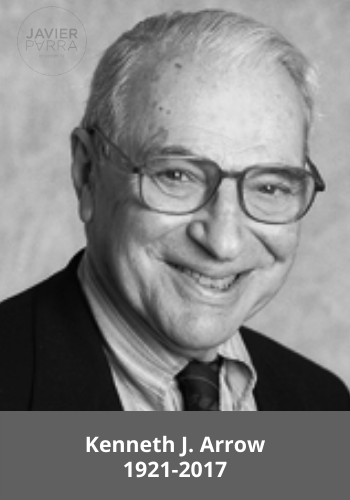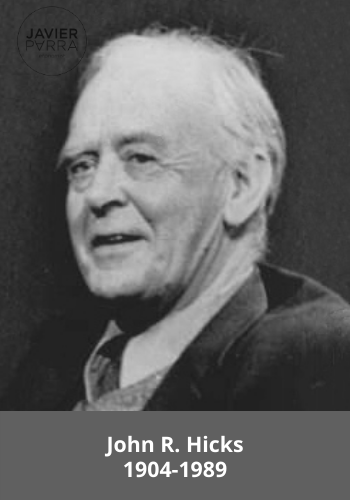In 1972 the Royal Swedish Academy of Sciences decided on 25 October to award the Nobel Prize in Economics in Memory of Alfred Nobel to Kenneth Arrow and John Hicks for “their fundamental contributions to the general theory of economic equilibrium and the theory of welfare”.
The theory of general equilibrium has led to progress in economic science, and we can say that this development is largely due to the work of Kenneth Arrow and John Hicks, who are the driving forces behind new productive avenues for research in this area. Although it was indeed Hicks who initiated this process in 1930, it was not until the 1950s and part of the 1960s that Arrow’s involvement gave a boost to the area of research that gave shape to the final work.
Kenneth J. Arrow

Born on 23 August 1921 in New York, he began his academic career at the City College of New York after completing his secondary education. In 1940 he obtained a Bachelor of Sciences (Bs) in social sciences with a specialisation in mathematics.
Admitted to Columbia University in 1941, he received a Master of Arts (MA) degree and continued his research work in the university’s Economics Department. World War II interrupted Arrow’s research, and from 1942 to 1946, he served in the United States Army Weather Service, where he became a captain. His responsibilities were more scientific than military and allowed him to publish his first scientific article entitled “Optimal use of winds in the establishment of a flight plan”. From 1946 to 1949, he worked on his research at the Cowles Commission (under the direction of Koopmans, who would win the Nobel Prize in 1975) and his doctoral studies at Columbia University obtained his doctorate in 1951.
In 1948 he was hired by the University of Chicago as an assistant professor. At the same time, he participated in research on game theory and mathematical programming at the RAND Corporation, when he began his work on social choices and Paretian optimality.
In 1949 he was hired by Stanford University, where he remained until 1968, teaching Statistics and Operations Research, the same year in which he accepted a teaching position at Harvard University. He met Debreu (who would go on to win the Nobel Prize in 1983) with whom he formulated the Arrow-Debreu theorem in an article entitled “Existence of an Equilibrium for a Competitive Economy”, in which they demonstrated the existence of a set of equilibrium price points in a theoretical economy based on the work of Leon Walras. His university career ended in California at Stanford University. In 1991 he became emeritus and continued to do new research on various topics.
As an academic, Arrow has worked in various fields such as general equilibrium and welfare theory, social choice theory, risk and insurance theory, racial discrimination theory and organisational theory. Arrow’s mathematical background is clearly reflected in his high level of abstraction.
Kenneth Arrow is the youngest Nobel laureate until 2001, receiving the Nobel Prize at 51. He holds approximately 20 honorary degrees, including the John Bates Clark Medal of the American Economic Association and the National Medal of Science, in addition to the Nobel Prize.
John R. Hicks

Born in Warwick, England, in 1904, he began his studies at Clifton College. Later, at the age of 18, he entered Balliol College, Oxford, where his mathematical talent earned him scholarships that covered part of the cost of his studies. Despite his gifts as a prodigious mathematician, he was openly inclined towards philosophy, political science and economics.
He was recruited by the LSE (London School of Economics), where he stayed until 1935. At first, he taught labour economics and industrial relations, but later, he turned to the analytical side of economics. It was under the tutelage of the British economist Lionel Robbins (head of the LSE’s economics department) that he turned to analysis and theory and accentuated this inclination through his discussions with Von Hayek (winner of the Nobel Prize in 1974), Roy Allen, Nicholas Kaldor and Ursula Webb-Hicks, whom he later married.
From 1935 to 1938, John Hicks taught at Cambridge, where he published his main work “Value and Capital”. On the microeconomic side, in 1932, his article “Theory of Wages” was an attempt to reformulate the theory of marginal productivity, introducing his famous “elasticity of substitution“. In 1934 he presented a work in which he explained the decomposition of demand into substitution and income effects, complementarity and definite substitution. Thanks to Hicks, English-speaking economists became familiar with the derivation of demand curves and the use of indifference curves and budget constraints and the equation of marginal rates of substitution and relative prices.
In 1936 he made an important contribution to economic science, the so-called IS-LM model, which is a graphical representation of the argument that John Maynard Keynes gave in the “General Theory of Employment, Interest and Money”, where he saw how an economy could be in equilibrium with less than full employment.
He was subsequently employed as a lecturer from 1938 to 1946 at the University of Manchester. In 1946 he returned to Oxford, where he remained until his retirement in 1971. Despite his retirement, he continued to publish articles and books.
Although Hicks’s inclination was indeed towards theory, he participated in several applied types of research in Public Finance, 1950. He was a member of the Nigerian Revenue Distribution Commission, and together with his wife in 1954, he surveyed the finances of Jamaica.
It is worth noting that John R. Hicks was ennobled by the Queen, who knighted him in 1966. Those who knew him to describe his character as easy-going and pleasant.
Both Hicks and Arrow have also made important contributions to fields other than those mentioned above: Hicks to monetary theory and business cycle theory, and Arrow to growth theory and decision theory. Kenneth Arrow and John Hicks belonged to two different generations of scientists, which is very noticeable when tracing their choice of problems and analysis methods.






